As the sun peeked through the branches, a young sparrow chirped eagerly, eagerly awaiting its next meal. Its parents, perched nearby, kept a watchful eye, ready to swoop in with a tasty morsel to nourish their growing hatchling. Feeding baby birds the right diet is crucial for their development and survival, and understanding the appropriate foods for these feathered friends can make all the difference.
Baby birds typically consume the same foods as their adult counterparts. They eat a variety of insects, worms, seeds, and fruits. These foods provide the necessary sustenance for nestlings and fledglings to grow and thrive. It’s important to avoid feeding baby birds cow’s milk, as it can cause stomach disturbances and should be strictly off the menu.
Key Takeaways
- Baby birds primarily consume insects as their main source of nutrition, alongside some fruits and vegetables.
- Birdseed and peanuts can be fed to baby birds in small amounts as supplemental feed.
- It’s crucial to ensure that any insects provided are small enough for the bird to swallow easily to prevent choking hazards.
- Avoid feeding baby birds cow’s milk as it may cause stomach disturbances.
- Contact a wildlife rehabilitation center before attempting to feed an injured or orphaned baby bird.
Types of Baby Birds
There are two main types of baby birds: altricial and precocial. Knowing the difference is key to giving them the right care and food.
Altricial Baby Birds
Altricial baby birds are born without feathers and can’t move on their own. They depend on their parents for food and warmth. They need to be fed every 30 minutes or so to grow well.
Precocial Baby Birds
Precocial baby birds are born with feathers and can move and feed themselves. They follow their parents to learn where to find food. They are more independent than altricial birds.
Knowing which type of baby bird you have helps in caring for them. Understanding baby bird development and bird nesting behavior is crucial for their health and happiness.
Nutritional Requirements for Baby Birds
Proper nutrition is key for baby birds to grow and develop healthily. A diet rich in protein is vital. It helps with their fast growth and the making of new tissues, feathers, and organs.
Insects, worms, and other high-protein foods are vital for baby birds. They meet the baby bird nutrition needs and help nestlings and fledglings. Without enough protein, baby birds may face health problems and grow slowly.
Importance of a Protein-Rich Diet
Baby birds, especially altricial ones, need a diet full of protein. Foods like insects and worms give them the amino acids they need. Without enough protein-rich diet, they might grow slowly, have weak immune systems, and get sick more easily.
“A balanced, protein-rich diet is crucial for the healthy development of baby birds. Providing the right nutrients supports their rapid growth and ensures they have the energy and resources they need to thrive.”
By giving baby birds a protein-rich diet, caregivers help meet their nutritional needs of nestlings and fledgling dietary requirements. This supports their health and well-being.
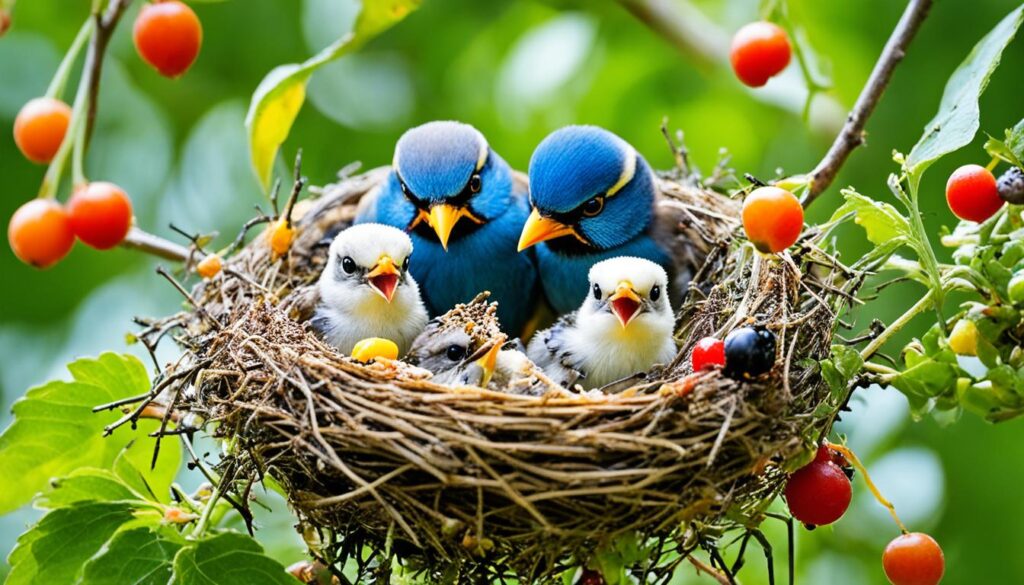
Common Foods for Baby Birds
Baby birds need certain foods to grow and develop well. Their diets change with their species, but some foods are key for all. These foods are important for nestlings and fledglings.
Insects and Worms
Insects and worms are crucial for baby birds. They give a lot of protein. Mealworms, crickets, and other small bugs are great because they’re full of nutrients. These foods help baby birds grow and get strong.
Seeds and Grains
Seeds and grains are also good for baby birds. You can buy special seed mixes for them at pet stores. These mixes have the right balance of carbs, fats, and nutrients. Sometimes, cooked rice or oatmeal can also be given in small amounts.
Fruits and Vegetables
Fruits and veggies add variety and important vitamins and minerals to baby birds’ diets. Soft fruits like bananas, berries, and melon can be mashed for them. Cooked, diced veggies like carrots, peas, and sweet potatoes are also good.
It’s key to pick the right food for the baby bird’s species and age. A mix of insects, worms, seeds, grains, fruits, and veggies is best. This mix supports the food for baby birds, insects and worms for baby birds, seeds and grains for baby birds, fruits and veggies for baby birds, and appropriate diet for nestlings and fledglings.
“Proper nutrition is essential for the growth and development of baby birds. A varied diet that includes a range of food sources can help ensure they receive all the necessary nutrients.”
Feeding Schedules for Baby Birds
Caring for baby birds is a delicate task that requires a consistent feeding schedule. Altricial baby birds, those born with their eyes closed and without feathers, need to be fed every 15-20 minutes from sunrise to sunset. This rigorous schedule mimics the hard work of their parents, who feed their nestlings non-stop.
As the baby birds grow and their eyes open, they can be fed every 30 minutes. Once they can stand on their own, the intervals can be extended to 45 minutes. By the time they are ready to leave the nest, baby birds can be fed every 2 hours.
Keeping the right feeding schedule for baby birds is key for their growth and development. The timing of baby bird meals should be consistent, starting at sunrise and ending before sunset. This ensures the baby bird feeding frequency meets their nestling feeding requirements.
“Success in handfeeding baby birds is measured in precious drops, and new babies may resist feeding initially.”
The temperature of the food is also important, as it should be around 100 degrees Fahrenheit. This warmth makes the baby birds feel comfortable and encourages them to eat.
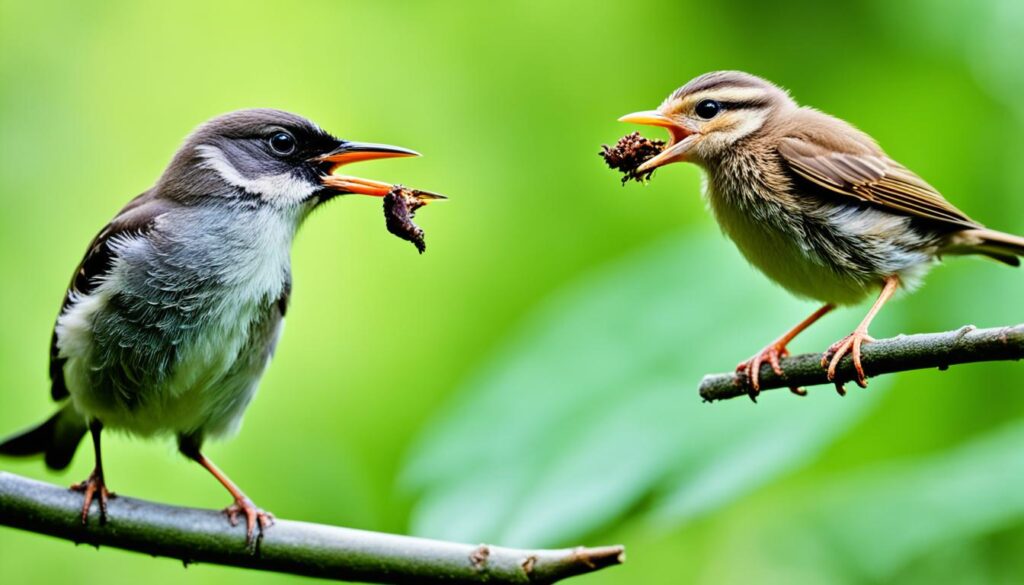
- Feed altricial baby birds every 15-20 minutes from sunrise to sunset.
- Reduce the frequency to every 30 minutes once their eyes are open.
- Further extend the intervals to 45 minutes when they can stand on their own.
- By the time they are ready to leave the nest, feed them every 2 hours.
Keeping a consistent feeding schedule for baby birds is key for their health and well-being. By following these guidelines, you can ensure your feathered friends get the proper care and nutrition they need to thrive.
Proper Feeding Techniques
Caring for baby birds means paying close attention to how you feed them. The right tools and methods are key. Using Popsicle sticks or straws helps you feed them safely without harm.
Feeding Tools
Tools like syringes or feeding tubes are great for baby birds. They let you feed them the right amount without overdoing it. This helps prevent health problems from overfeeding.
Avoiding Overfeeding
It’s easy to overfeed baby birds. To avoid this, watch the baby bird’s crop closely. It should be full but not too big after feeding. Keep feeding until it’s just rounded, not bulging.
Using the right tools and watching for hunger signs helps you feed them safely. This supports their growth and health.
“Proper feeding techniques are essential for the well-being of baby birds. Avoid overfeeding and use the right tools to ensure a safe and nourishing experience.”
What can baby birds eat?
Caring for baby birds is both delicate and rewarding. They need a variety of nutrients for fast growth and development. Baby birds can eat insects, worms, seeds, grains, fruits, and vegetables.
It’s important not to give baby birds milk as it can harm their stomachs. Instead, feed them soaked mynah bird pellets or dry dog food, baby food, turkey, cooked egg yolk, and a little water. This diet helps nestlings and fledglings grow strong.
- Insects and worms are great for baby birds because they are high in protein.
- Seeds and grains, like sunflower heart chips, give them carbs and minerals.
- Fruits and vegetables add vitamins and fiber to their diet.
Feeding baby birds regularly and using the right feeding methods is key to their health. A varied and nutritious diet helps them grow and reach their full potential.
“A nest full of ten chicks requires 1,000 caterpillars daily.”
Looking after baby birds takes patience, dedication, and knowledge of their diet. By following these tips and getting advice from wildlife experts, you can help the next generation of birds.
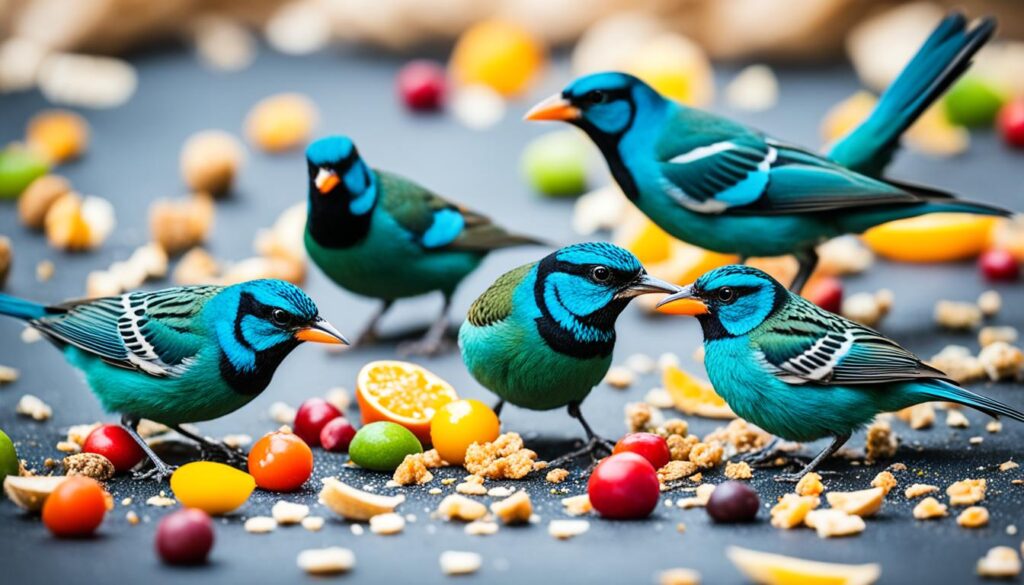
Signs a Baby Bird Needs Help
Seeing a baby bird can be exciting, but knowing when to step in is key. If you find a nestling or fledgling that looks injured, bald, or can’t fly, it might need help from experts.
Look for signs like wet or tangled feathers, inability to fly, or visible injuries. Don’t touch the bird as it could hurt it more. Instead, call a local wildlife rehab center for advice.
Injured or Orphaned Birds
Nestlings are young birds that can’t survive alone and need rescue and expert care. Fledglings are bigger, feathered, and learning to fly with their parents watching. About 80% of baby birds brought in for help are actually just learning to fly and don’t need rescue.
If a baby bird is sick, hurt, or really in danger, get help from a wildlife rehab center or vet right away. Trying to feed or care for it without the right skills and tools can hurt it more, like making it hard to breathe.
“During hot summer months, dehydration is common among baby birds, leading to wrinkled and shrunken bellies.”
Putting the bird in a safe spot, like a bush or tree, can keep it safe from predators and people. But if you’re not sure if the bird needs help, it’s best to ask a wildlife expert.
Caring for Fledglings
As baby birds grow, they move from nestlings to fledglings. These young birds have feathers and leave the nest. They need a bigger space with perches to fly and find food by themselves. It’s good to give them natural foods right away to help them learn to feed on their own.
Don’t mess with fledglings too much, as their parents are still teaching them important skills. These birds need to eat often, from morning till night. Their diet should be high in protein, like small pieces of raw kidney or liver, boiled egg yolks, and protein-rich dog biscuits soaked in water.

Mealworms soaked in water are great for fledglings because they’re full of protein and calories. You can also feed them sunflower seeds, waxworms, dried mealworms, and soaked sultanas, raisins, and apples. But, don’t give them whole peanuts or bread because they can choke on them.
Give fledgling birds a warm, quiet spot and keep their feeders clean with fresh food. Also, planting gardens that help wildlife and not using chemical sprays can make a safe place for them to grow.
“Enjoying fledgling season from a distance is recommended to avoid disturbing nest sites and causing stress to nesting birds.”
By following these tips, we can help our young birds leaving the nest transition to independence. And we can make sure they stay healthy and happy.
Consulting Wildlife Rehabilitators
If you find a baby bird that looks hurt, alone, or upset, call a local wildlife rehab center. These places have experts who know how to help the bird. Trying to help the bird yourself might actually hurt it more.
Most states need permits and training for wildlife rehab. Many birds also need federal permits. You can find licensed rehabbers by searching “wildlife rehabilitator near me” or looking at a map of local groups.
Watch the baby bird from afar, as its parents might still be around. Adult songbirds may need help if they get hurt by cats, cars, hitting windows, or get sick. Look for signs like not moving, not flying away, puffed-up feathers, eye problems, bleeding, or hurt limbs.
- Put the injured bird in a cardboard box in a cool, safe spot. Don’t try to feed or give it water.
- Find a local wildlife rehabber and take the bird there as fast as you can.
Don’t take hatchlings or nestlings from the wild unless you really have to. The parents are still taking care of them. Hatchlings and nestlings don’t have feathers, have thin down, and closed eyes. They need the warmth and care of their mother. If you find a nestling on the ground, make a fake nest to keep it safe until help arrives.
Fledglings can stand, move, and eat on their own while staying on the ground. It’s usually best not to touch healthy fledglings. They are just learning to fly.
“Consulting a wildlife rehabilitator is the best way to ensure the baby bird’s well-being and increase its chances of survival.”
https://www.youtube.com/watch?v=wbCUBMSdo6c
Creating a Bird-Friendly Yard
Homeowners can easily make their yards a safe place for baby birds. By planting native plants, you offer food and shelter for young birds. It’s also key to avoid using pesticides since they can hurt baby birds and the insects they eat.
Native Plants
Native plants are a big help for local bird populations. They fit well with the local climate and are a steady food source for birds. For example, native oak trees support up to 557 butterfly and moth species, while non-native ginkgo trees support only 5. Using a mix of native plants makes your yard a great place for baby birds and helps keep local bird populations strong.
Avoiding Pesticides
Pesticides can be very harmful to baby birds. 96% of land birds eat insects to feed their young, and pesticides can cut off this food source. Also, pesticides can hurt young birds, threatening their health and survival. By staying away from pesticides and choosing organic gardening, you can create a safe space for baby birds.
Working to make your yard bird-friendly is good for the local ecosystem and baby birds. By planting native plants and avoiding pesticides, you can really help the next generation of birds.
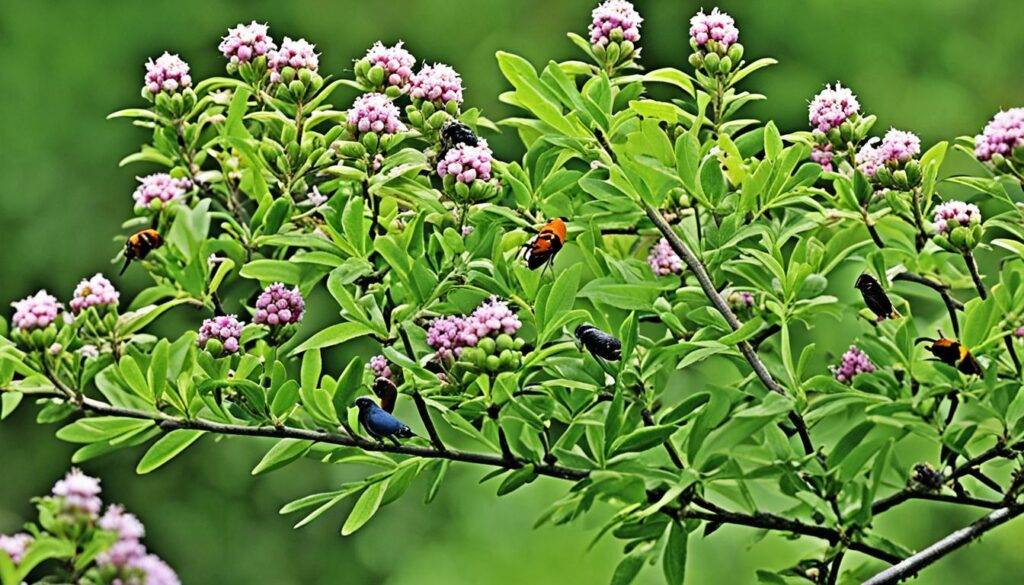
“Native plants, on the other hand, support a balance of predator and prey and thrive without pesticides.”
Observing Baby Bird Development
Watching baby birds grow is both captivating and enlightening. From the early nestling phase to the independent fledgling stage, they change a lot. Seeing them learn and grow is a great way to connect with nature and understand life cycles.
Learning about the different stages of baby bird development helps us see their challenges. It also makes us appreciate their journey to adulthood more. This knowledge builds a stronger bond with birds and teaches us about their life cycle.
- Altricial baby birds, like robins and sparrows, are born helpless and need a lot of care. Both parents feed and take care of them.
- Precocial baby birds, such as ducklings and chicks, are more independent from the start. They can move, feed themselves, and follow their parents soon after hatching.
The growth of baby birds is amazing, with clear stages that show their adaptability and strength. By watching these stages, we learn more about their behavior and life cycle.
“Watching the stages of baby bird development unfold is a true marvel of nature. It’s a privilege to see these feathered wonders grow from vulnerable hatchlings to independent fledglings.”
Keeping an eye on baby birds helps us understand their health and the health of local bird populations. By watching their development, we learn about the challenges they face. This helps us appreciate their life cycle more.
Myths and Misconceptions
There are many myths and misconceptions about caring for baby birds. These can lead to actions that are not helpful. By knowing the truth, we can give these young birds the best care.
One myth is that touching a baby bird will make its parents abandon it. But birds don’t smell very well, so they won’t reject a bird that has been touched by a human. So, you can safely put a young bird back in its nest.
Another myth is that baby birds need milk. But birds can’t digest dairy well. They should eat insects, worms, seeds, and fruits instead. This diet is good for their growth.
“The majority of ‘abandoned’ baby birds are healthy fledglings who do not need assistance. Parent birds usually care for four or five young scattered in different directions.”
It’s also wrong to think that all young birds found on the ground are orphaned. Many are fledglings, birds that have left the nest but are still being looked after by their parents. Helping them too soon can be harmful.
Understanding and fighting myths about baby birds and misconceptions about caring for young birds helps us support these birds well. This way, they can grow up successfully.
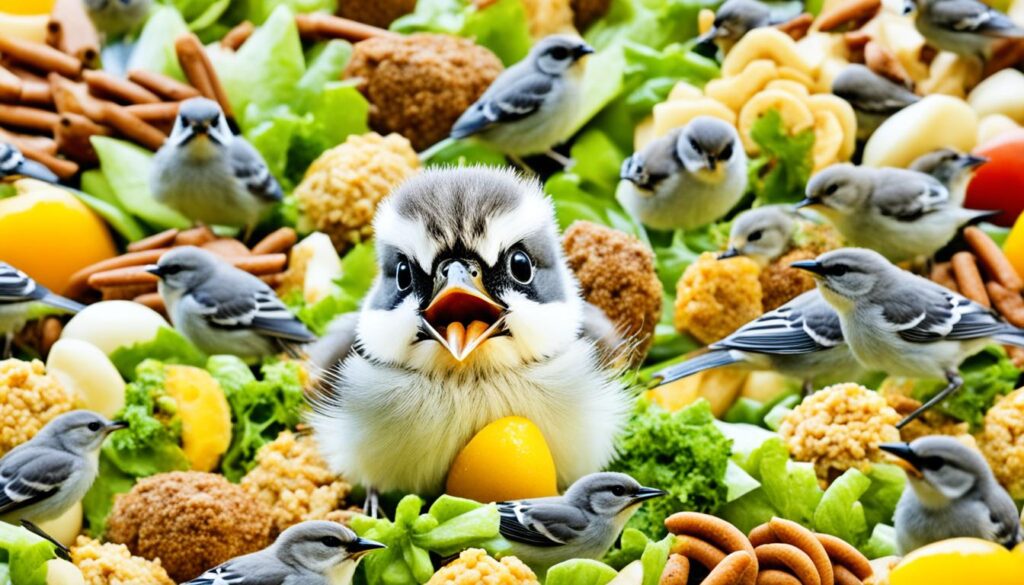
To debunk common baby bird myths and separate fact from fiction in baby bird care, trust expert advice and good sources. With this knowledge, you can make choices that really help the young birds you care for.
Conclusion
Feeding and caring for baby birds is key to their growth. They eat a diet full of insects, worms, seeds, and fruits, focusing on protein. It’s important to feed them regularly, use the right feeding methods, and not overfeed.
If a baby bird looks injured or needs help, call a local wildlife rehab center. They can give you the right advice.
Creating a bird-friendly yard helps baby birds survive and succeed. The bucket nest method is a great way to help fledglings stay safe with their parents. Getting the community involved can make a big difference for these birds.
Key points for helping baby birds include giving them the right food, a good home, and getting expert help when needed. Doing these things helps baby birds grow into healthy adults.
FAQ
What can baby birds eat?
Baby birds eat the same foods as their parents. This includes insects, worms, seeds, and fruits. Avoid giving them milk as it can make them sick. Instead, feed them a mix of soaked mynah bird pellets, dry dog food, baby food, turkey, cooked egg yolk, and water.
What are the different types of baby birds?
Baby birds come in two types: altricial and precocial. Altricial birds are born naked and need their parents to feed them. Precocial birds hatch with feathers and can move and feed themselves.
Why is a protein-rich diet important for baby birds?
Baby birds need a lot of protein to grow and develop fast. Foods like insects and worms give them the nutrients they need. Without enough protein, baby birds may get sick or grow too slowly.
What are some common foods for baby birds?
Baby birds eat many foods, including insects, worms, seeds, grains, fruits, and vegetables. Insects and worms are key for their growth. Seeds and grains offer more nutrition, and fruits and vegetables add vitamins and minerals.
How often should baby birds be fed?
Baby birds need to be fed often, especially altricial species. Feed them every half-hour during the day. They don’t need food at night but should be fed when you wake up and before bedtime.
What techniques should be used when feeding baby birds?
Use the right tools and methods to feed baby birds safely. Use popsicle sticks or straws for feeding. Don’t overfeed them. Stop when their crop is full to avoid health issues.
What can baby birds eat?
Baby birds can eat insects, worms, seeds, grains, fruits, and vegetables. Don’t give them milk as it can make them sick. Feed them a mix of soaked mynah bird pellets, dry dog food, baby food, turkey, cooked egg yolk, and water instead.
What are signs that a baby bird needs help?
Look for signs like wet or matted feathers, not being able to fly, or looking injured. If a baby bird is injured, bald, or can’t fly, it might need help from a wildlife center.
How should fledglings be cared for?
Fledglings need extra care as they learn to fly and find food. Give them a big area with perches to practice flying. Start giving them natural foods to help them eat on their own.
When should a wildlife rehabilitator be contacted?
Call a wildlife rehabilitation center if you find a baby bird that seems injured, orphaned, or needs help. These experts can give the right care and treatment.
How can a yard be made more bird-friendly for baby birds?
Make your yard bird-friendly by planting native plants that feed and shelter birds. Don’t use pesticides as they can harm baby birds and the insects they eat.
What are some common myths and misconceptions about caring for baby birds?
A common myth is that humans touching a baby bird will make the parents reject it. But birds don’t smell well, so they won’t mind. Another myth is that baby birds need milk, which can actually make them sick.
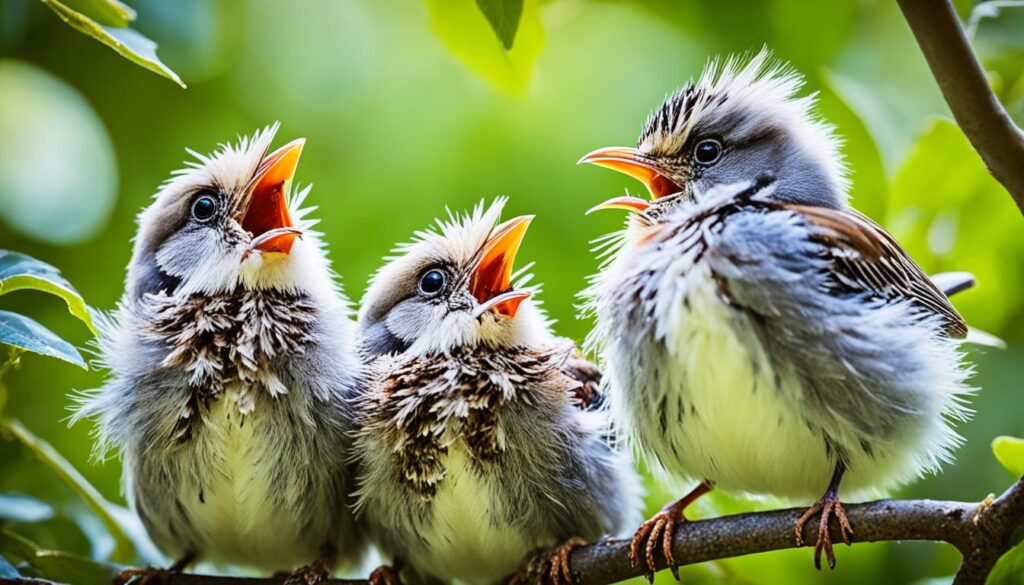

безопасная сделка аккаунтов https://ploshadka-prodazha-akkauntov.ru
Online Account Store Account Sale
accounts marketplace accounts for sale
database of accounts for sale https://accountsmarketdiscount.com
website for buying accounts website for buying accounts
online account store secure account sales
database of accounts for sale buy and sell accounts
gaming account marketplace https://social-accounts-marketplace.live/
buy facebook profile facebook ad accounts for sale
buy fb ad account https://buy-ad-account.click/
buy facebook profiles facebook ads accounts